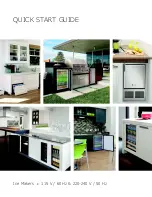
17
1. Sequence and Component Diagnosis
3)
Power On
: Turn on the power supply, then move the control switch to the "ICE" position.
A 5-sec. delay occurs. CB red "POWER OK" LED and CB green "BC CLOSED" LED
turn on. If CB yellow "BC OPEN" LED is on (indicating a full bin), check BC. Move ice
away from BC actuator paddle. If CB yellow "BC OPEN" LED stays on, see "II.E.1. Bin
Control Check."
Note: • CB red "POWER OK" LED remains on unless the 10.5VAC power supply is
interrupted (K2 connector).
• Check CB using the steps in "II.D. Control Board Check."
• Confirm CB green "BC CLOSED" LED is on. If CB yellow "BC OPEN" LED is on,
remove ice from BC. If no ice is around BC and CB yellow "BC OPEN" LED is
on, see "II.E.1. Bin Control Check."
a)
Power On Diagnosis:
If CB red "POWER OK" LED is off, confirm 10A fuse is good.
Check for 115VAC at control switch #1 (BK) to neutral (W) then at control switch
#2 (P) to neutral (W). If 115VAC is present on #1 (BK) and not on #2 (P), replace
control switch. If 115VAC is present on control switch #2 (P), check for 115VAC at
HPS (P) to neutral (W) then HPS (BK) to neutral (W). If 115VAC is present at HPS
(P) and not at HPS (BK), HPS is open. See HPS Diagnosis below. If 115VAC is
present at HPS (BK), check for 10.5VAC at CB K2 #1 red wire to CB K2 #2 red wire.
If 10.5VAC is not present, check that the cleaning valve is closed and the interlock
switch is closed. Next, check CT continuity. If open, replace CT.
b)
HPS Diagnosis:
Check that the condenser coil is not clogged or restricted. Let
refrigeration circuit pressures equalize. If HPS does not reset and pressures are
equalized, replace HPS. If pressures are not equalized, reclaim refrigerant and
diagnose refrigeration circuit restriction. Check that there are no restrictions in the
refrigeration circuit.
Harvest Cycle: HGV, strainer, or check valve.
Freeze Cycle: FM, FMR, TXV, WRV, HM, LLV, strainer, check valve, drier, and
damaged line set or fitting.
Confirm that the location meets installation requirements:
• The appliance is not intended for outdoor use. Normal operating ambient temperature
should be within 45°F to 100°F (7°C to 38°C).
• Allow 6" (15 cm) clearance at rear, sides, and top for proper air circulation and ease
of maintenance and/or service should they be required.
• The appliance should not be located in a corrosive environment.
















































